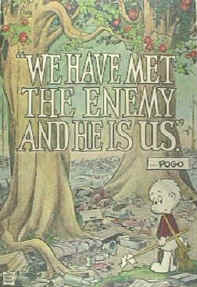(Props to Mr. Shakespeare for a sick title)
“The love of money is the root of all evil.” (1 Timothy 6:10)
 In the modern world, the money of most nations is based on bank credit. This is sometimes called “fiat money”, (often understood in a derogatory sense) but I don’t think that term does justice to the problems with modern money. It really just means a currency without an intrinsic value. The more fundamental problem with the modern systems of money based on bank credit is that the money is created on the fly, de novo (in other words, out of thin air), whenever a special kind of bank (usually called a central bank or reserve bank) issues credit. In most cases such debt must be repaid with interest which is a bit like the game of musical chairs–there are never enough chairs (money supply) to cover all the outstanding debts if the music were to stop. That may be madness, and some suggest that such credit-based money is the true root of all evil–or at least an important source of the world’s current social and economic woes. I think the evils and their supposed impacts on civilization may be exaggerated a bit.
In the modern world, the money of most nations is based on bank credit. This is sometimes called “fiat money”, (often understood in a derogatory sense) but I don’t think that term does justice to the problems with modern money. It really just means a currency without an intrinsic value. The more fundamental problem with the modern systems of money based on bank credit is that the money is created on the fly, de novo (in other words, out of thin air), whenever a special kind of bank (usually called a central bank or reserve bank) issues credit. In most cases such debt must be repaid with interest which is a bit like the game of musical chairs–there are never enough chairs (money supply) to cover all the outstanding debts if the music were to stop. That may be madness, and some suggest that such credit-based money is the true root of all evil–or at least an important source of the world’s current social and economic woes. I think the evils and their supposed impacts on civilization may be exaggerated a bit.
Before I go on let me borrow some basic definitions from Wikipedia:
“Money is any item or verifiable record that is generally accepted as payment for goods and services and repayment of debts… The main functions of money are distinguished as: a medium of exchange; a unit of account; a store of value; and, occasionally in the past, a standard of deferred payment. Any item or verifiable record that fulfills these functions can be considered money.” http://en.wikipedia.org/wiki/Money
“Commodity money is money whose value comes from a commodity of which it is made. Commodity money consists of objects that have value in themselves as well as value in their use as money.” http://en.wikipedia.org/wiki/Commodity_money
“In commodity money, intrinsic value can be partially or entirely due to the desirable features of the object as a medium of exchange and a store of value. Examples of such features include divisibility; easily and securely storable and transportable; scarcity; and difficulty to counterfeit. When objects come to be used as a medium of exchange they lower the high transaction costs associated with barter and other in-kind transactions.” http://en.wikipedia.org/wiki/Intrinsic_value_%28numismatics%29
Some think that using a currency with some intrinsic value and a finite supply, like gold or silver, will solve the money problem. I am skeptical, so I am trying to make sense of the confusing subject of money and alternative currency.
“Plastic” money (credit and debit cards and the like) and their processing systems just move “bits” of information around from one computer and customer account to another. They have the same effect as writing debit and credit entries in a bank ledger. That kind of money is called a unit of account. It is generally associated with a technology of some kind like ledger books, computers, marks on clay tablets, strings of beads, coins, paper “coupons” or “notes,” etc. Some of these tokens may have uses or qualities other than as units of account and so may be thought to have “intrinsic value.” Intrinsic value may be completely unrelated to the monetary value as a unit of account. One form of value slightly different from intrinsic value is perceived value based on trust, acceptance, custom, etc.
One of the most popular alternative currencies is bitcoin, but I have been reluctant to fully embrace it for reasons that were not really clear to me until I discovered the following quote from Adam Smith:
“Labour was the first price, the original purchase-money that was paid for all things. It was not by gold or by silver, but by labour, that all wealth of the world was originally purchased.”
~Adam Smith
I think this might be the key for a new kind of money that can take any physical form but is “backed” (given its nominal value, face value, or par value) by units of labor, not by bank credit or on any supply of precious material. (Curiously, one might say that the alternative currency bitcoin is based on machine labor, i.e. mining.)
As long as the value of money is ultimately based on (backed by) labor, I think it may be safer to use whatever currency, token, or proxy is most convenient for a particular kind of transaction. The caveat is that currencies, whether they have intrinsic value or not, are not neutral or inert. Each kind of currency has built-in attributes that may affect the equity of transactions, especially if these attributes are not obvious to all parties.
Bank-issued, credit-based money; gold, silver, or other precious materials; barter exchange systems, etc.– all have their intrinsic “issues”. Credit-based fiat money may be well-suited to a cashless digital world, but the same absence of intrinsic value may appeal to unscrupulous financial engineers who find it ideal for obscuring risk in and price information in complex derivative products. In the brave new world of proprietary currency we may also see a new generation of “weaponized” currencies entering the intellectual property arms race:
“Apple … requires all apps sold for their platform to go through Apple’s centralized payment system, which generates considerable revenue as they take a 30% cut of all revenues. Some developers tried to bypass this restriction by sending their users to make in-app purchases elsewhere, but Apple eventually banned the practice. And Facebook, with its new Facebook Credits system, is seeking to do the same. Replacing the choice of competing virtual currencies with a mandate to use their own, they intend to extract the same 30% tax that Apple does from all revenues made within their ecosystem. (How Bitcoin may undo the Apple/Facebook 30% sales tax, blog.p2pfoundation.net)
I am no currency expert and I’ll not try to survey the pros and cons of various real and imaginary forms of currency. I am simply suggesting that any currency we use might have more legitimacy and stability if it were ultimately based on (backed by) labor.
Many will object that labor is a poor value standard because the value of labor varies according to the qualities of labor (abundance, expertise, fitness for a given purpose, etc.). But to argue that the value of one person’s labor or time differs from another’s is to claim that the value of different people’s lives varies.
Oh, really?
The products or results of one person’s labor may be more valuable than the products of another persons labor, but we need not (in fact I believe we must not) conflate the value of the product or service with the value of the labor or the person– despite the tempting convenience and simplicity of so doing. Many things go into the value of a good or service besides the cost of labor. My proposal is only that the value of a unit of human labor should be universal and that this value might become the ultimate standard behind the value of any basic unit of currency. Might that make it easier to keep track of risk and value even if financial engineers converted labor into other units or bundled time into derivatives?
(I’ll leave it to others to debate the relative values of a man-hour, a woman-hour (grin), an ox-hour, a machine-hour, etc.)
Seriously, though, I am still struggling to analyze the implications of Adam Smith’s statement. One nagging idea is to separate the time that is devoted to work from the value of the creative or productive results. A unit of human time (person-hour, person-minute, etc.) would have the same universal value for any person participating in the system. There shouldn’t be any need to assign any another form of value (dollars, for example) to the basic time units. They posses their own intrinsic value–your minutes are worth the same as mine.

In our usual way of thinking we say that different people’s time (and by extension, their lives) have different economic values depending on their relative productivity; but also, at the same time, we want to believe that everyone’s life has a non-economic moral or social value. We also want to say that each human being’s moral value is equal . There seems to be a constant state of contradiction and tension between “apples and oranges”, between economic, social and moral value systems. An unproductive bum may also be a social liability and yet s/he may be “just as precious in the eyes of God” as a hard-working, family-raising pillar of the community.
It may seem intuitive to simply make a distinction between the monetary value and the moral value of a person’s time, labor, life, etc.; but doing so may in fact, if my hypothesis is correct, be a slippery slope towards evil, because it introduces an element of hypocrisy and cognitive dissonance.
Labor’s love lost?
Instead of monetizing labor, maybe we should be labor-tizing money.
Poor Richard
Addendum
I caution that my labor-value hypothesis is still fraught with hard questions. In the comments to this post I have a dialogue with a relatively hard-core money abolitionist who argues that a commons-based economy can operate without currency. My preference would be a hybrid economy that uses money along with other ways of controlling fair and sustainable access to the commons. No matter what accounting technology or theory we consider, I don’t foresee a fair economy free of score-keeping any more than a science free of measurements. Nature works without money, but it works largely without all other abstractions, including language, too. I don’t see a human society reaching its potential without money or language.
I’m inclined to think that many (if not all) the ills we blame on the money system are reflections of human nature. That is why I’m not a complete fan of “gift economies” or other philosophically-based money reforms such as the “sacred economics” of Charles Eisenstein. I like some of the ecological concepts and social sentiments of those programs, but I’m skeptical of the practicality and scalability of the proposed solutions for a large, complex, modern society. I don’t think they fully account for deeply embedded human biases that are legacies of evolution. If the ills we blame on the money system are reflections of human nature acting in specific ways under specific environmental conditions, we might reform money or create a new system only to find the old problems creeping back in. We see this in things like land reform programs where land is redistributed more fairly only for concentration of ownership to gradually return, perhaps because of a lack of education, including economic literacy, in the general population. I don’t think Eisenstein and other gift economy proponents adequately address this potential “rubber band effect” that may result from intransigent cognitive and cultural biases, especially when we try to change ONE thing, like money, without understanding and changing enough of the related cognitive, social, and economic variables at the same time.
I may end up siding with those who argue that a currency is better off backed by nothing at all but confidence or trust. Its really all about digital accounting, anyway, and we have that down already (ATM’s, debit cards, and online banking). The part that is screwed up is that a bunch of old white dudes called “Reserve Bankers” have an exclusive (and in the US, unconstitutional) franchise to post unlimited digital money into their own accounts, without it accounting for anything real they traded or sold. Then they lend that made-up money to you and I or the government at interest!
I don’t hold with arguments that money or banking per se are evil. Both can be benevolent if used the right way. A non-profit community savings & loan bank or a credit union protects and rewards the savings of the community and finances the community’s local self-development with the community’s own savings. Borrowers pay a little more interest than savers receive. The small spread between the loan interest rate and the savings interest rate pays for the overhead costs of the credit union or non-profit bank. If you ask me, that’s all good.
But two things never seem to mix without becoming pathological: banking and the profit motive. When banking is operated for profit, the incentives always seem to get twisted around and the system gets gamed.
A minimum basic income as a human right?
The standard value of a life would need to be computed by some algorithm and that would be fraught with issues, but however it was computed, it would be a floor, not a ceiling, to the subjective values that others might place on a given life for whatever reasons. My proposal may really be a back-door way to argue for a basic minimum income as a human right.
Unfortunately, I don’t think my proposal does anything to solve the problem of some people being worth more dead than alive….
Related articles
- Helping sustainable currencies to scale (communityforge.net via p2pfoundation.net)
- Fureai kippu is a Japanese sectoral currency created in 1995 by the Sawayaka Welfare Foundation so that people could earn credits helping seniors in their community.[1] The basic unit of account is an hour of service to an elderly person.
- Occupy Economy: The case for soft money by Sepp Hasslberger
- How Trust Is Built in Peer-to-Peer Marketplaces (shareable.net)
- Sacred Economics with Charles Eisenstein [Shareable.com Interview] How can we change money to embody the good things about gift economies and so that it’s in alignment with the new stories of the connected self and instead of conquering nature, co-creating with nature? What if money was designed to be an extension of ecology rather than exception to it? In my book I go into the nitty gritty of how money could be changed to not be the enemy of all the beautiful things we want to do.
- Common Good Finance (Banking & alternative currency. “Real community. Real money. Real power.”)
-
A Capital Idea Part 118: Making Money Real, Robert Warden (thomhartmann.com)
- Alternative Currency Thriving in Greece (izabael.com)
- 13 States Considering Alternative Currencies (blacklistednews.com)
- Big Ideas For A New Economy: Social Currency Unleashed (fastcoexist.com)
- What is Bitcoin – WeUseCoins
- Community Currency Magazine
-
Complementary Currency Resource Center (Includes a worldwide database of complementary currencies)
- The Metacurrency Project: The MetaCurrency Project is part of the movement of emergent currency systems, whether you think of them complementary currencies, alternative currencies, local currencies, digital currencies, virtual currencies, reputation currencies or targeted currencies. We are building the tools to enable all them. We even defined our Open Data approach for distributed, digitally-signed transaction chains over a year before bitcoin was invented.We’re connected to the movement to enable a truly P2P, distributed internet without central points of control or failure. Our project embodies the goals of the movement of the 99% which seeks to reclaim the capacities for wealth generation from a privileged few.
Related Videos
- Book Discussion on The 21st Century Case for Gold (C-SPAN video 29.05)
George Gilder talked about his book, The 21st Century Case for Gold: A New Information Theory of Money. Gilder argues that time is the ultimate basis for many diverse standards of value.
- A brief history of money
- The future of money? (clip from IN TIME (2011) – Justin Timberlake)
- Money optional (Pun Pun permaculture seed commons in northern Thailand)



 cheek, turn to him the other also.” (Matthew 5:39, King James Version)
cheek, turn to him the other also.” (Matthew 5:39, King James Version)


 Church of Reality
Church of Reality Critiques Of Libertarianism
Critiques Of Libertarianism P2P Foundation
P2P Foundation Stanford Encyclopedia of Philosophy
Stanford Encyclopedia of Philosophy The Stone
The Stone